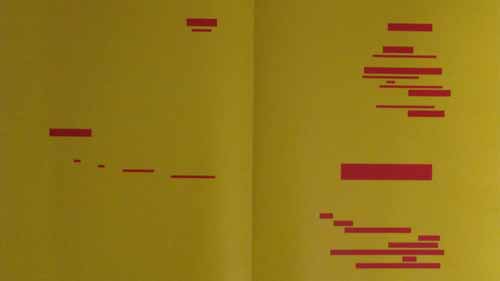The Higher Dimensions of the Poem (Part 1)

Eric Zboya is one of my talented, advanced undergrads in English Literature at the University of Calgary, where he is currently finishing up his research on the poetic themes of "transcendental dimensionality" in the book Un Coup de Dés by Stéphane Mallarmé. Zboya is experimenting with a series of interesting, translative procedures in order to explore the motif of "blank space" within this notoriously challenging poem. Zboya has seen fit to use current, digital technology so as to emphasize the "empty depth" of the words upon the page, accenting some of these spatialized, dimensional motifs of the book, using techniques unavailable to Mallarmé at the time of publication in 1897. Zboya has agreed to let me conduct an interview with him (in two short parts) so that you might get a glimpse of the various results from his amazing project.
Can you tell me about the poem Un Coup de Dés by Stéphane Mallarmé? How have you gotten interested in doing experimental translations of this poem?
Many critics argue that Un Coup de Dés represents one of the most cryptic poems ever composed, so to sum up the poem in a few brief sentences might prove difficult. The poem essentially describes the aftermath of a shipwreck—a shipwreck that signifies the annihilation of syntax, in which the semantic debris of the vessel drifts aimlessly within the expanse of the page, almost like galaxies of stars wandering through the vastitude of space. This syntactical pandemonium helps to create, what I call, a "nonlinear lattice"—a lattice that acts as a kind of gateway into a higher-dimensional environment beyond the two-dimensional space of the page. For me, this idea expresses the true meaning behind Un Coup de Dés—the idea that a Cartesian, geometric field exists deeply within the page itself. I have also read The Book to Come by Maurice Blanchot and The Dynamics of Space by Virginia A. La Charité, and I love their ideas about how Un Coup de Dés signifies an experience of transcendence that is not merely textual, but also wholly spatial. I have also begun to meditate upon ways to express these notions through my own visual poetry, using contemporary technologies. My translations showcase the results of these investigations.
Can you describe some of the processes used by your predecessors to translate this poem? How have they responded to its "spatialisme"?
Even though Marcel Broodthaers, Guido Molinari, and Michalis Pichler use different techniques to exhibit the spatial themes of dimensionality in Un Coup de Dés, all of these translators share a common approach, in that they all eliminate the referential text from the page. Broodthaers, for example, renders each line of text as a proportional series of black rectangles, all of which project like shadows through the translucent pages of the book, appearing gradually into view, then fading away, with each turn of the page. Molinari, likewise, replaces the lines of text with rectangles, except that, in his case, he employs a palette of bright colour to help delineate these spaces more vibrantly within the depths of the page. Pichler also takes this idea of erasure to an entirely new level by literally excising the lines of text, through the use of a laser, so that what remains is only a series of negative spaces, or "anti-spaces," which almost act as dimensional doorways into the other pages of the book….
Translation by Marcel Broodthaers

Translation by Guido Molinari

Translation by Michalis Pichler

Christian Bök is the author of Crystallography (Coach House Press, 1994), a pataphysical encyclopedia...
Read Full Biography

